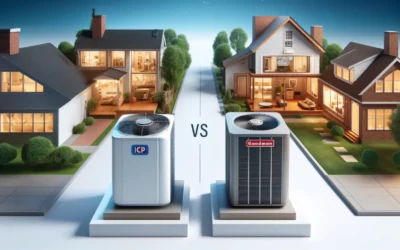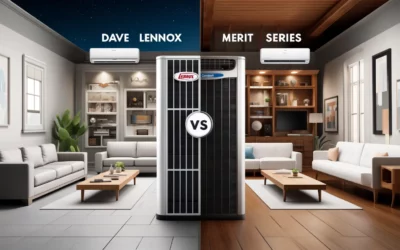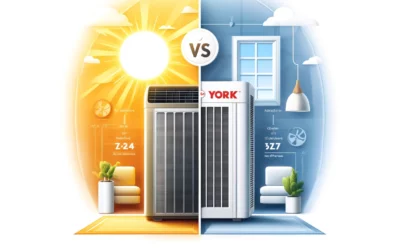Welcome to this insightful post titled “Understanding Mold Growth in Your AC’s Evaporator Coil”. In this guide, we shall throw light on the conditions that lead to mold growth in your AC’s evaporator coil and how it can affect your air conditioning system’s performance. As we delve in further, you will learn not only how to identify this often unseen issue, but also the ways to prevent and eliminate it. This post leans heavily on expert opinions and factual data, presenting you with credible and practical knowledge. Perfect for homeowners and AC maintenance enthusiasts, our guide aims to enhance your understanding of air conditioning systems, thereby helping you maintain a clean, efficient, and healthy AC unit. So, whether you’re battling with mold issues or merely interested in preventive AC measures, you’re in the right place!
Understanding the Basics of Your AC’s Evaporator Coil
The core element of your cooling system is the evaporator coil. Composed mainly of copper tubes, the main function of the evaporator coil is to absorb the heat from your indoor air. This is accomplished as the refrigerant flowing in these coils evaporates under the effect of a heat source, hence the name ‘evaporator’. As the warm vapor cools down, the dehumidified air is then blown back into your living space to maintain a comfortable temperature.
The necessary environment for mold growth includes a moisture source, warmth, darkness, and an organic ‘food’ source. Unfortunately, such conditions are ideal within your AC’s evaporator coil, which often comes in contact with dust and organic matter present in your indoor air. As part of your AC’s dehumidification process, water droplets collect on the evaporator coil. When combined with dirt particles and warmer ambient temperature, these moisture areas can become breeding grounds for mold.
- Common signs of mold growth in your AC’s evaporator coil:
- – Musty odour whenever AC is running
- – Increased respiratory allergies
- – Visible mold spots
- – Unusual high energy bills
When it comes to mold growth prevention or mold removal, regular maintenance plays a vital role. It includes checking on your evaporator coil on a routine basis for any signs of mold and other possible damages. It is also significant to ensure that your indoor humidity levels are controlled to decrease the chances of mold growth.
Acquainting Yourself with the Causes of Mold Growth in Evaporator Coils
Your AC’s evaporator coil plays a vital role in ensuring that the air in your house stays cool and comfortable. However, these coils, due to their moist and dark environment, can sometimes turn into a breeding ground for mold. This growth is primarily triggered by a few specific conditions.
Firstly, the presence of organic material can significantly contribute to mold growth in your evaporator coils. Dust, which carries dead skin and other organic matter along with it, often settles in these places, thus providing the mold with a food source. Secondly, humidity plays a crucial role as well. Excessive humidity, especially in climates where it tends to be high, can create a moist environment that is conducive for mold.
| Cause | Explanation |
|---|---|
| Organic Material | Presence of dust, dead skin and other organic matter can provide food for mold, aiding its development. |
| Humidity | Higher levels of humidity can create a moist environment, ideal for mold growth. |
Furthermore, poor maintenance can also lead to mold growth. If the AC system is not regularly cleaned and serviced, the build-up of dirt and debris can eventually lead to mold. Lastly, even small leaks can increase the likelihood of mold in evaporator coils- slow leaks can go unnoticed for a long period, providing a constant source of moisture for mold.
-
Organic Material: Dust builds up over time and provides a potent food source for mold.
-
Humidity: High humidity levels make your AC’s evaporator coil a perfect breeding ground for molds.
-
Poor Maintenance: Irregular cleaning and servicing of your AC system leads to build-up of dust and debris, promoting mold growth.
-
Small Leaks: Undetected slow leaks can provide a constant source of moisture, facilitating mold development.

Identifying the Signs of Mold in Air Conditioner Coils
Mold growth in your air conditioner coils is not just a pesky issue; it can lead to health problems and impact the performance of your AC system. Many homeowners aren’t aware of the threat until it’s too late. Therefore, being able to identify the signs early is crucial.
Unusual Smell: The very first sign that there is mold in your air conditioner coils is an unusual moldy smell whenever you turn on your AC unit. You might also notice this smell in certain areas of your home or even in your bedding or clothing. The stronger this smell, the more likely it is you have a problem with mold. Visible Mold: Perhaps the most concrete sign is seeing mold itself. If you inspect your air conditioner’s coils and detect a fuzzy or slimy substance, it’s likely that it’s mold. Be careful not to touch or inhale near this substance, as it can be harmful.
| Signs | Description |
|---|---|
| Decreased AC Performance | Your AC might not cool your home as it once did, or it may take longer to reach the set temperature. This could be due to mold hindering your AC’s performance. |
| Increased Energy Bills | Because of the decreased performance, your system has to work harder, therefore consuming more energy. This will eventually reflect in your monthly bills. |
Health-Related Symptoms: Besides the telltale signs in your AC unit, you may also feel the effects physically. Some common symptoms people have experienced in relation to mold exposure include:
- Breathing difficulties or wheezing
- Trouble sleeping or concentrating
- Nasal congestion
- Itchy eyes and skin
It’s important that you don’t ignore these signs and seek professional help to handle this situation. A mold issue should be removed by a professional to maintain the health and well-being of your household.

The Health Implications of Mold in Your Air Conditioning System
Air conditioning systems are an integral part of our daily lives, especially during extreme weather conditions. However, they bring with them the potential risk of mold growth. The AC’s evaporator coil, being dark, damp, and often dust-ridden, provides the perfect environment for mold to flourish. Long term exposure to these molds can result in numerous health issues including respiratory problems, skin irritations, and even neurological problems.
If your AC system has been running for a long period, it would be wise to inspect it for potential mold growth. So, here are some ways to spot mold growth:
- An unusual, musty smell coming out of your AC vents.
- Physical symptoms such as prolonged coughing, sneezing, or eye irritation when you’re at home, which tend to vanish when you’re outside for long hours.
- Actual mold spots visible around the AC vents or the evaporator coil itself.
However, identifying the problem isn’t enough. It is equally important to take preventive measures. Here are some tips on how to prevent mold growth in your AC’s evaporator coil.
| Action | Explanation |
|---|---|
| Regular Cleaning | Cleaning your AC system and particularly the evaporator coil can help keep mold at bay. |
| Humidity Control | Keeping the humidity levels below 50% in your home can vastly decrease the chances of mold growth. |
| Professional Maintenance | Regular professional maintenance of your AC system can identify and rectify any potential mold issues before they become a serious threat. |
While preventing mold growth might seem like an intimidating task, remember that it is essential for your health and well-being. By routinely inspecting, cleaning, and maintaining your AC’s evaporator coil, you can prevent the harmful repercussions of mold exposure.
Effective Strategies for Preventing Mold Growth in AC Coils
Understanding the Environment
Mold thrives in moist and dark environments, and unfortunately, your AC’s evaporator coil provides both these conditions in abundance. The cold refrigerant that circulates the coils often condenses the surrounding moisture in the air, resulting in a high level of humidity. To effectively combat mold growth, you need to control the environment - limit the moisture and increase the light exposure.
Moisture Management: Consider investing in a dehumidifier to maintain the optimum humidity level in your home, ideally between 30-50%. Periodic cleaning of the AC coils can also keep the moisture under check. Ensure that the condensate drain line functions smoothly to promptly remove any water accumulation.
Light Exposure: If feasible, consider using ultraviolet (UV) light in your AC system. UV light is known for its mold-crushing abilities and can prevent their growth.
Diligent Maintenance Practices
Regular AC maintenance is another efficient strategy to prevent mold growth. Over time, dirt and grime can accumulate on your AC coils, providing mold with ample nourishment to flourish. By keeping your AC system clean and well-maintained, you can deny these unwanted guests the resources they need to grow.
Regular Cleaning: Regularly cleaning your AC coils with a coil cleaner can effectively remove any mold present and prevent future growth. Always remember to turn off the AC before cleaning.
Changing Air Filters: Changing the air filters in your AC system is another important step towards preventing mold growth. Over time, these filters can accumulate dust particles and moisture, creating an ideal breeding ground for mold. Standard practice is to replace these every 30-60 days.
Lastly, for professional insight and thorough cleaning, scheduled services by HVAC experts is highly recommended. They possess the knowledge, experience, and tools necessary to maintain your AC system’s health, ensuring it remains free from mold and other contaminants.
Detailed Steps for Cleaning and Removing Mold from Air Conditioner Coils
When it comes to maintaining the quality and efficacy of your air conditioning unit, tackling mold growth is a must. While it might seem daunting, the process isn’t quite as tricky as you’d think. Detailed below is a comprehensive step-by-step guide on how to rid your evaporator coils of mold.
Step 1: Safety First Equip yourself with a face mask and gloves. This is crucial as you’ll be dealing with mold spores which can be harmful if inhaled or if they come into direct contact with skin. Remember to turn off electricity supply to your air conditioner before beginning any kind of cleaning or maintenance tasks.
Step 2: Inspect the Evaporator Coil Use a flashlight to thoroughly inspect the coil. Look out for patches of black, green or brown, which are potential signs of mold growth.
Step 3: Cleaning the Mold Using a commercial grade mold cleaner, spray the affected areas. Allow the cleaner to take effect for the recommended time mentioned on the product. Then, scrub the coil gently with a soft brush.
Step 4: Rinsing and Drying the Coil Rinse the coils gently with clean water. Ensure you don’t wet other AC components. Ideally, use a spray bottle for this step. Once rinsed, allow the coil to dry completely before turning on the air conditioner.
By following these detailed steps, the mold can be effectively removed from your AC’s coils. However, be mindful of recurring mold, as it could be indicative of an environment that’s conducive to mold growth, such as excessive humidity. Regular cleaning and maintenance of your AC unit can assist in preventing mold infestation.
Professional Services Vs DIY: Choosing the Best Mold Removal Methods for Your AC
While many homeowners opt for DIY methods in an attempt to save costs on mold removal, a more in-depth consideration sheds light on the efficiency and efficacy of professional services. DIY methods, including vacuuming and scrubbing with a variety of solutions like vinegar, bleach, or baking soda, are popular for surface mold removal. However, the limitations of these methods often show up in their inability to eliminate mold completely, especially in hidden or hard-to-reach areas like your AC’s evaporator coil.
On the other hand, Professional services offer comprehensive mold removal, from inspection and testing to removal and future prevention. Armed with advanced equipment and expert knowledge, professionals are able to penetrate surfaces and access all areas of your AC, thereby ensuring a complete eradication of mold.
- DIY methods: Cost-effective for surface mold, may not eliminate mold completely
- Professional services: Expensive, but offers comprehensive mold removal
| Methods | Advantages | Disadvantages |
|---|---|---|
| DIY | Cost-effective for surface mold | Struggles with complete removal, especially in hard-to-reach spaces |
| Professional Services | Comprehensive eradication | May be more expensive |
While the decision between DIY and professional services ultimately lies in your hands, understanding where and how mold grows can help inform your choice. Mold favors a humid environment and the evaporator coil of your AC unit, which condenses humidity from your home’s air, is a prime location for mold growth. If left untreated, it can cause a multitude of problems, ranging from health issues like allergies and respiratory conditions to appliance inefficiency and failure. Therefore, assessing the extent of the mold invasion and choosing the most effective removal method is crucial.
Wrapping Up
In wrapping up, understanding how mold grows in your AC’s evaporator coil is integral in maintaining the health and lifespan of your air conditioning unit. Remember to constantly clean and check on your system to preemptively strike against any potential mold growth. Although this may seem daunting, the benefits clearly outweigh the labor involved. Regular maintenance enables the conservation of your AC’s proper functioning and overall efficiency, thus saving money in the long run.
While the information provided in this article will certainly help you comprehend how mold cultivates in your unit, don’t hesitate to reach out to professionals if you suspect a serious problem. Experts are more trained to handle these situations and can ensure that your air conditioning system will return back to operating at its best. After all, your health and comfort are paramount. So, keep this knowledge at your fingertips, stay vigilant, and continue to enjoy a fresh, cool and healthy atmosphere in your living or working space.









